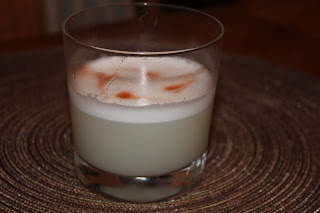As mentioned in my last post, I have a small bottle of a Portuguese liqueur called Ginja, perhaps the most unusual thing in my liquor cabinet. It's 38 proof and taste very sweet, like the syrup in a bottle of maraschino cherries. It isn't as strong a flavor as my Luxardo Maraschino liqueur and does not feature as complex a flavor profile. Traditionally, it is either sipped as a dessert or taken in shots. Further adding to my challenge, I think I bought a crappy brand. I saw this particular brand in a lot of stores and picked it up pretty cheap, but looking at Google Images, there are some bottles that look nicer, though I really can't gauge quality on this type of drink at all.
Before getting to the drinks, a couple thoughts about trying to salvage "challenging" spirits.
1. Don't be afraid to fail, because you probably will.
2. Feel free to throw away bad drinks. If something taste bad, don't feel guilted into finishing it. It will make such experimentation most unpleasant.
3. Don't use the highest end spirits to mix your first tries. You will waste good booze.
4. Make half drinks. Since you will probably make mistakes, make them smaller.
5. Start simple and work towards complex. Before you understand the basics of how a spirit works with others, avoid more complex concoctions.
6. Find analogues and work from there. For instance, if yours is a sweeter, tarter, stronger, or weaker version of a more common spirit, consider trying a variation on a drink using that spirit but adjust the ratios of all ingredients based on the special characteristics of your new spirit.
Onto the trials and errors.
My first attempt was a variation on the Boulevardier, which uses bourbon, Campari, and sweet vermouth. The idea was to balance the sweetness of Ginja with the bitterness of Campari. This drink, as I will discuss, deserves no name.
Ingredients:
1.5 ounces of bouron (Jim Beam)
.5 ounces of Campari
.5 ounces of Ginja
Directions: Stir with ice and strain into a chilled glass and garnish with a lemon peal.
Outcome: Utter failure. Perhaps the ratios could have been a bit different (the Boulevardier uses more vermouth and Campari. Really though, I don't think this had much of a shot. The Campari overwhelmed the Ginja, which mixed with the bourbon to give a sickly, sort of medicine-like aftertaste. I did not finish the drink.
My next attempt, which I will call
The Slipper, was a variant on a martini. This was not very ambitious but avoided the bad interplay between the bourbon and the Ginja.
Ingredients:
2 ounces of gin
.5 ounce of dry vermouth
.5 ounce of Ginja
Directions: Stir with ice and strain into a chilled glass.
Outcome: Surprisingly not bad. Not particularly good, but certainly drinkable. If anything, I probably could have added a bit more ginja, as it kind of get's lost behind the vermouth and the gin (I used
Beefeater). As pungent as Ginja is, the drink's nose was dominated by the gin. The balance was relatively good and the contrasts in flavors worked reasoanbly well. At a technical level there was nothing wrong with the drink, I just didn't particularly like it. I think this is a personal thing that I have with cherries. I like cherries - I just don't really like them in stuff.
Cherry pie? No thanks. Jam? I'll pass. Garnish for a
Manhattan? I'll go with the orange peal.
My last attempt took for inspiration a drink I found on Webtender I think. I'm calling it Abe's Revenge.
Ingredients:
2 ounces of orange juice
1 ounce of blended Scotch
.5 ounce of sweet (French) vermouth
.5 ounce of Ginja
Directions: Stir ingredients with ice and strain into a chilled glass. Further recommendation, unlike what I did, strain the OJ through a sugar sifter to get rid of the pulp. It will make your drink look nicer and taste smoother.
Outcome: Legitimately decent. This drink was something that I might have again at some point. The interesting thing is that the tastes seem to progress - from OJ, to scotch, to Ginja and vermouth. The cherry gives the drink a pleasant smell and the flavors balance relatively well. I'm still not in love with the cherry flavor of Ginja, but it works pretty well here.








